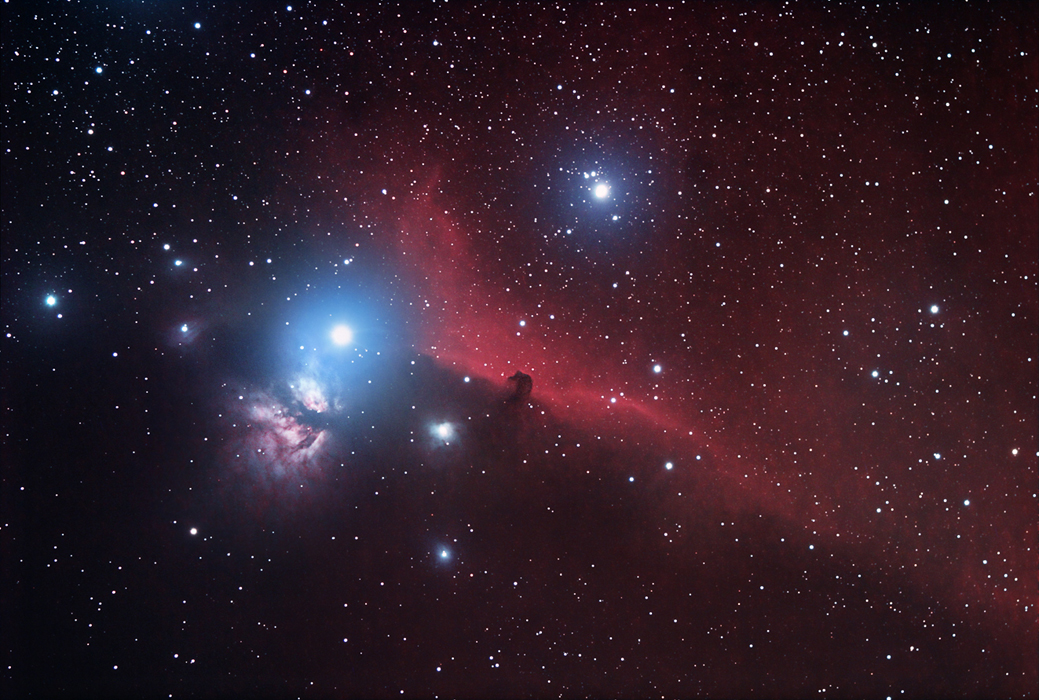The Horsehead Nebula and Neighbors
Characteristics:
Magnitude: Unknown
Distance: 1600 light years (Horsehead Nebula, aka B33); 826 light years
(Alnitak- Zeta Orionis); 1165 light years (Sigma Orionis)
RA: 5h 40m 56s
Dec: -1 degrees 56' 21"
Description:
This is one of the most interesting regions of the night sky,
containing 3 different types of nebulae: emission, reflection,
and dark. The Horsehead Nebula itself, also known as Barnard 33
(B33), is
part of an enormous dust cloud that extends to the left and downward in
this
photo, obscuring light from behind (notice the relative lack of stars
in
the lower half of the image). Red light from IC434, the large
emission nebula coursing diagonally through the field, is partially
obscured by the Horsehead itself. IC434 is actually part of a
large gasseous region in Orion, extending towards and involving the Great Orion Nebula
(M42). If your monitor is adjusted correctly, you will be
able to make out some of the faint nebulosity from this region,
extending upwards and to the right of the field, heading towards M42.
To the upper right of the
Horsehead at 1 o'clock is the bright star Sigma Orionis, which is
responsible for producing the UV radiation that excites hydrogen atoms
in IC434 to emit in the red. To the left of the Horsehead at
about 9 o'clock is the large
Flame Nebula, aka NGC2024 or Orion B. This is also an emission
nebula,
although the stars reponsible for its glow are buried deep inside and
are
not visible. Notice the dark lanes or "veins" within the Flame,
which
are thought to represent an extension of the same dark nebula
responsible for creating the Horsehead. The brightest star in
this region is Alnitak, aka Zeta Orionis, and created an enormous
amount of interference in my unprocessed image that obscured the
uppermost region of the Flame. Alnitak forms the left hand
portion of Orion's
belt and is much
closer to us than either the Horsehead, IC434, or NGC2024 (and it is
therefore
not responsible for illuminating any of the other objects in the
field).
Finally, there are several beautiful blue reflection nebulae in
this
image, visible because they are in the foreground of the dark nebula
itself.
These reflection nebulae are IC435 in the lowermost portion of the
image,
NGC2023 to the immediate left of the Horsehead, IC432 to the upper left
of
the Flame, and IC431 just above IC432. Please
click here for
a higher resolution image of this region.
Photographic Details:
Date: November 23, 2003- early
morning.
Scope: Takahashi Sky 90 at f4.5 with field flattener/focal
reducer, piggybacked on LX90 (which is mounted on a Meade Superwedge).
Autoguider: STV with e-finder.
Camera: Canon 10D.
Filter: IDAS LPS.
Exposures: 15 x 5' at ISO 1600, for a total
exposure time of 75 minutes.
Conditions: Temperature 35 degrees F; below
average transparency; average seeing; very dewy; calm.
Post-processing: Raw
conversion, adaptive dark frame calibration, alignment, min/max
excluded averaging done in ImagesPlus; Background compensation to correct for mild vignetting also
performed in ImagesPlus and worked extremely well for this image.
Levels, curves, and layer mask adjustments in Photoshop. Alnitak
was extremely bright in the original image and obscured part of the
Flame, requiring several curves adjustments of this region to enhance
the topmost portion of the Flame. As a result, I could not
capture as much of the Flame as I had hoped- this will require another
session using a shorter exposure time, which I
will eventually feather into the current image. This was one of
three
images shot during this session (the first two being the Pleiades
widefield and the Rosette, which
started in the late evening on 11/22/03).
Please
note: Graphics on this website may not be reproduced without
author permission.
Back to Nebulae
Home

